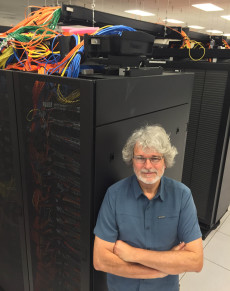David Turner to Retire from NERSC User Services Group
June 17, 2015
Long-time User Services Group consultant David Turner is hanging up his headset after 17 years at NERSC. His love of math, science and computers began when he was still in high school, and it has not waned over the years.
Here Turner, whose last official day is June 26, talks about how he first became interested in computer science and the diverse career path that ultimately brought him to Berkeley Lab.
How did you first become involved in HPC?
In 1974, before my senior year of high school, I attended a month-long math camp at Western Washington University (WWU), where we were taught BASIC and some simple number theory and probability. This convinced me that I wanted to do math and science on computers.
I returned to WWU after high school and earned a degree in Math/Computer Science, with lots of physics, astronomy and numerical analysis. After graduating in 1979, I got a job at Lawrence Livermore Lab doing scientific programming for various projects in the Physics Department. This led to a stint with the early Parallel Processing Project for a few years, as well as about five years as a group leader. I worked at LLNL for 13-and-a-half years, then stepped into private industry for a while, moving to Connecticut to work for Scientific Computing Associates. In 1997 I returned to the Bay Area and worked for Hewlett-Packard for about a year before coming to Berkeley Lab.
How long have you been at NERSC?
I began working in the User Services Group at NERSC in 1998. My first day of work was also my birthday, so a group of us went out after work to celebrate. I’ve been here ever since.

David Turner, circa 1999
What attracted you to working here?
I’ve been familiar with NERSC for my entire professional career, as I was a user of MFECC/NERSC when it was still located in Livermore. So I understood its basic mission and was excited to share my HPC experience across a user base that spans so many interesting science fields.
What has been your favorite part of working here?
I have to split this into two answers. The first is, of course, the staff. The NERSC team has always been top-notch, and management has been very supportive. I've made many good friends in my time with NERSC.
The other aspect of this job that has been really rewarding is the science results our users produce. I've always been a science news junkie, and being part of an organization that has contributed to so many recent big scientific achievements makes me feel really proud. For example: The rate of expansion of the universe is increasing? Never saw that coming!
What have been your proudest accomplishments while at NERSC?
I've always enjoyed mentoring junior staff members. It doesn't seem that long ago that I was "the new guy," and the mentors I had early in my career had a huge influence on me.
On the technical side, I am proud of the role I played in the procurement, installation and support of NERSC’s Carver system—which will retire just three months after I do!
What will you miss most after you leave NERSC?
The day-to-day interactions with my colleagues. We joke that we’re more like a family than a group of co-workers, but there’s some truth to that. It's also been fun trying to explain to family and friends over the years exactly what I do for a living. I finally came up with five words that describe my entire career: "I help scientists use computers."
What are your plans for the future? Will you continue to be involved with NERSC or the Lab?
The usual retirement stuff: travel, spend time with family and engage in hobbies that I've never had sufficient time to explore as deeply as I'd like. I will continue to follow science developments in general and NERSC's contributions in particular. But my time in HPC is coming to an end, and I have no plans to dabble in it after I retire.
About NERSC and Berkeley Lab
The National Energy Research Scientific Computing Center (NERSC) is a U.S. Department of Energy Office of Science User Facility that serves as the primary high performance computing center for scientific research sponsored by the Office of Science. Located at Lawrence Berkeley National Laboratory, NERSC serves almost 10,000 scientists at national laboratories and universities researching a wide range of problems in climate, fusion energy, materials science, physics, chemistry, computational biology, and other disciplines. Berkeley Lab is a DOE national laboratory located in Berkeley, California. It conducts unclassified scientific research and is managed by the University of California for the U.S. Department of Energy. »Learn more about computing sciences at Berkeley Lab.








